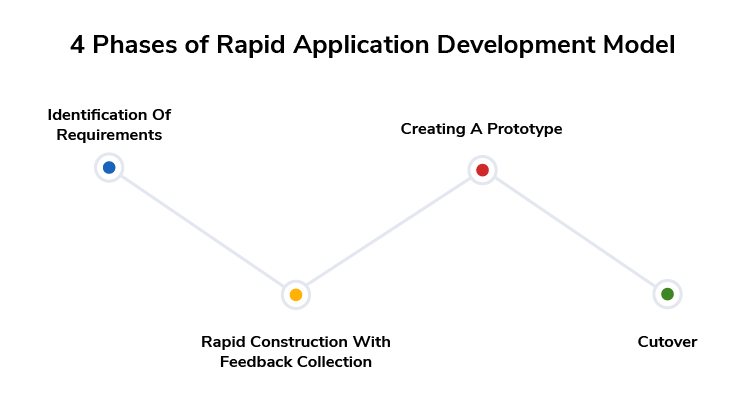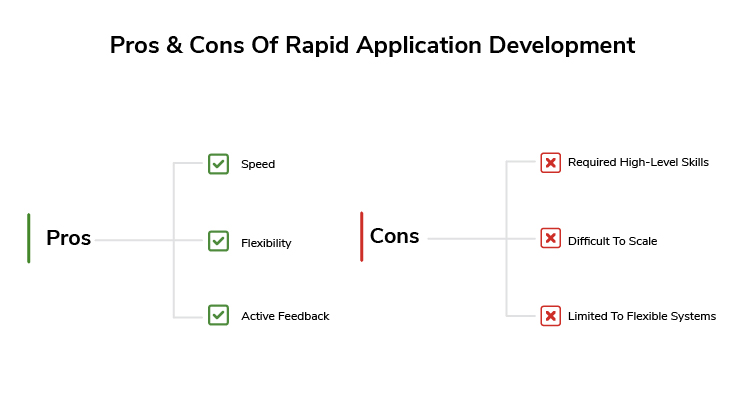Imagine you are building a skyscraper. During construction, changes to the building design would be costly and time-consuming. This is similar to traditional software development, where changes to the design and functionality of the application take more work to implement midway through development. Rapid Application Development (RAD) is a blueprint that is constantly evolving and adaptable to change.
With RAD, developers can rapidly prototype and test new ideas and make changes to the design and functionality of the application without disrupting the overall progress or negatively impacting the end product. It allows for flexibility and agility in the software development process, much like how a skyscraper can be easily redesigned on paper before construction begins.
The market of rapid application development is anticipated to grow at a Compound Annual Growth Rate of 42.6% from 2022 to 2026.
It sounds interesting, isn’t it?
In this article, we’ll explore the details of rapid RAD. So that we can understand what it is, the pros and cons of RAD, and how it can benefit your business.
Are you ready?
Let’s get started…
What Is Rapid Application Development?
Rapid Application Development is a software development methodology that prioritizes speed and efficiency. The goal of RAD is to quickly deliver a working software product through prototyping and iterative development. This approach allows for quick changes and adjustments during the software development process, allowing the final product to meet user needs more effectively.
The RAD methodology was first introduced in 1991 by James Martin (an information technology consultant and author) as a response to traditional software development methodologies’ slow and rigid nature.
Since then, it has become a popular choice for businesses who are looking to deliver working software products quickly.
Now, let’s explore the phases of RAD methodology.
4 Phases of Rapid Application Development Model
The RAD model differs from traditional software development methodologies because it prioritizes speed and flexibility. With RAD, developers can quickly and efficiently implement new features and functionalities while prioritizing speed and user testing to ensure the final product meets client expectations.
Here are the 4 phases of rapid application development;

Phase#1: Identification of Requirements
It is a crucial step in the development process as it sets the foundation for the rest of the project. During this phase, stakeholders such as end users and project managers are consulted to determine the specific wants and needs of the software product. During this process, you might have to conduct market research, gather user feedback, and define the scope and objectives of the project.
So, it is essential for you to thoroughly identify and document all requirements to ensure that the final product meets the user’s needs and aligns with the project’s objectives. As a final step in this process, whenever necessary, convert word to PDF to bring your document to the required format.
Phase#2: Creating A Prototype
Once you’ve identified the requirements, the next phase is to create a prototype. This process entails creating a rough draft of the software product, allowing for testing and iteration before moving on to the final development stage. This is where you might want to use tools and software to assist you in creating the prototype. You can use some leading software like SAP Rapid Application Development to simplify the process by using visual tools, intuitive templates, and prebuilt components that come with this software.
However, for organizations implementing these software solutions, top-rated SAP consulting experts are essential for aligning their business processes with SAP’s capabilities. They assess the current IT landscape, evaluate existing processes, and collaborate with project managers and end users to gather vital insights.
Prototyping allows developers to explore and experiment with different design and functionality options, helping to ensure that the final product is user-friendly and fulfills users’ expectations. This way, developers can easily identify and resolve potential issues early in development.
Phase#3: Rapid Construction With Feedback Collection
During this phase, developers build the software using the prototype as a guide. The development of the final product (software) occurs in short iterations, which allows more flexibility to make adjustments as needed.
Additionally, constant feedback from the client makes it easy to build the final product in line with the client’s expectations and specifications.
Phase#4: Cutover
The final phase of the RAD involves transitioning the final software product from development to a finished product launch, making it available for use by end users.
In this phase, any necessary documentation and training materials are prepared, and the software is tested to ensure it is ready for use. Once all testing is complete, and the software is deemed ready, the client receives the software.
Pros and Cons of Rapid Application Development
In the real world, nothing is 100% perfect, so of course, the rapid application development methodology also possesses its drawbacks. Below, we’ve explained the pros and cons of RAD.

Pros of RAD:
- Allows for quick delivery of working software: One of the main benefits of RAD is its focus on speed. By prioritizing the delivery of working software, RAD allows businesses to bring new products to market and stay competitive quickly.
- Flexibility and iteration during the development process: Another advantage of RAD is its ability to adapt to changing circumstances. RAD’s prototype-based nature allows adjustments to be made throughout the development process, ensuring that the final product meets the user’s needs.
- Encourages active client involvement: RAD promotes the active involvement of clients throughout the development process. This helps to ensure that the final product aligns with the project goals and adheres to the client’s requirements.
Cons of RAD:
- Requires highly skilled developers/designers: RAD can be challenging for developers and designers who are not highly skilled in prototyping and iterative development. It requires a high level of expertise to implement the RAD methodology effectively.
- Difficult to scale: Because RAD is focused on small to medium-sized projects, it can be difficult to scale up to larger projects. Because of this, it is more difficult to implement RAD for projects with a wider scope or higher complexity.
- Limited to flexible systems: RAD is most effective when applied to flexible and adaptable systems. Implementing the RAD methodology may be more challenging if the system is not designed for flexibility.
When should you utilize the Rapid Application Development methodology?
Once you’ve reviewed the pros and cons of RAD, you may wonder whether or not this model is right for your business. And deciding whether or not to use the Rapid Application Development (RAD) methodology can take time and effort.
That’s why to help you make a quick decision, we’ve put together some questions that you can consider to determine whether RAD is right for you or not.
- Do you need to deliver a product quickly? If time is of the utmost importance, RAD may be a good fit as it allows for the rapid delivery of working software.
- Will you have access to feedback and user testing? RAD relies on constant feedback from stakeholders to ensure that the final product meets their needs. RAD may not be the best choice if you cannot gather reliable feedback.
- Is your product high-risk or mission-critical? If the software you are developing has the potential to cause harm or has a critical function, choose a different development methodology. For instance, software used for flight control or firmware implanted in humans are susceptible products, so RAD is not an appropriate option in this case.
- Do you have the necessary technical manpower? RAD requires highly skilled and experienced developers, designers, and coders. If you do not have the right personnel in place, it may be best to choose a different approach.
Wrapping Up
Rapid application development is highly beneficial for businesses interested in developing and releasing products quickly. It is also suitable for creating apps that are high-quality and cost-effective.
However, your company must evaluate its needs before developing, as RAD may not be the best solution for all products.
So, you must carefully evaluate and confirm your resource capacity in order to reap the benefits of rapid application development.